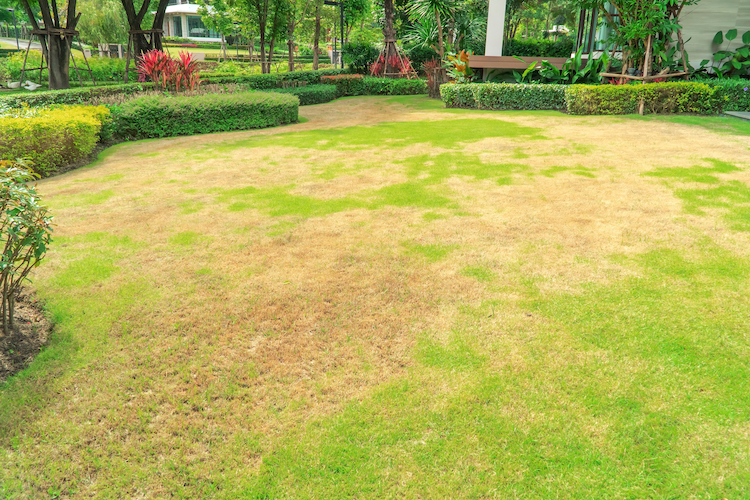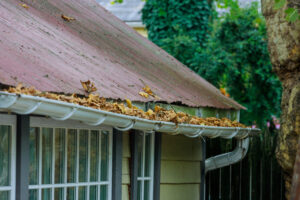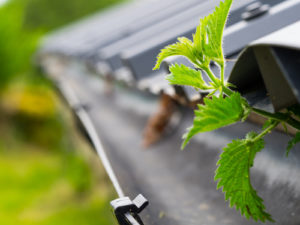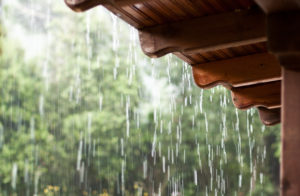Lawns are one of the first things people notice about a home. A home that’s full of weeds can be an eyesore. On the contrary, a home with a vibrant, lush green lawn is eye-catching and appealing. Whether you DIY your lawn care or hire a professional lawn care company, it’s quite a science to get the right combination of lawn care products to prevent weeds and fertilize.
Even though some lawns are well maintained they can experience that dreaded brown-ish yellow color, otherwise known as dead or dying grass. Unfortunately, every lawn is prone to dying grass regardless of how well you maintain it. Many things can result in brown grass – continue reading to learn about some possible causes and some fixes to get your lawn as lush and vibrant as possible.
Overwatering
If you own a home with a lawn then you’re probably used to some sort of watering schedule. You may have automatic sprinklers that pop up each day to water the grass or you may set up a sprinkler yourself to water the lawn in sections. Most homeowners water their lawns multiple times per week in the hot summer months and some even water multiple times per day. How much water does your lawn need? According to Scotts, the average lawn only needs 1-1.5 inches of water per week (slightly more if your lawn is not established).
The Heartland’s rainy season is from May-August, and we receive quite a bit of rain with storms that often bring heavy precipitation. While the summer months are scorching hot and your lawn may seem dry, keep in mind that recommended 1-1.5 inches of rain per week. Monitor the weather and adjust your watering schedule accordingly. Be sure not to overwater as oxygen won’t be able to penetrate the soil, resulting in dead grass.
Drought
Although the rainy season is during the summer months, there are days and even weeks where we don’t see any rain at all here in Kansas City, Overland Park, Lee’s Summit, and other surrounding cities. Long breaks in the rain often lead to a drought, especially when temperatures hover between 80-90 degrees and the sun is constantly shining. Again, lawns need around 1-1.5 inches of rain per week, so if there is no rain forecasted and you’re not watering your lawn then drought is inevitable and grass will die off.
To avoid drought and keep your lawn lush, create a watering schedule. If you have automatic sprinklers then set them to water a few mornings per week, reaching that 1-1.5 inches of water per week goal. If you don’t have automatic sprinklers, set up a manual sprinkler to water sections of your lawn at a time, but be sure not to overwater.
Weeds
One of the biggest nuisances for homeowners is weeds. They’re unsightly and take over lawns by way of a single seed that grows faster and multiplies more quickly than grass. There are many forms of weeds here in the Heartland from dandelions to clovers. All it takes for a weed to grow is a single seed, soil, water, and sunlight. Weeds are inevitable if you have a lawn, especially in early spring and summer. Weeds can also grow in the fall and winter months, taking over your lawn quickly—the more weeds that grow in your yard, the less grass that will grow.
To manage weeds and take back your lawn, consider hiring a professional lawn care company or DIY your weed control. You’ll want to choose the right combination of weed killer and fertilizer to kill off the weeds while fertilizing your lawn’s grass. A professional lawn care company will have the right combination on hand and will treat your lawn without you having to lift a finger. If you plan to DIY your weed control, do plenty of research for the correct weed killer and fertilizer you’ll need in our region.
Overflowing/Leaking Gutters
Remember how we mentioned earlier that overwatering results in oversaturated soil that blocks oxygen from entering the soil, ultimately killing the grass? Heavy rainfall and overwatering the lawn are often culprits of overwatering, however, your gutters also affect the health of your lawn.
If your gutter system is older, damaged, or has clogs, it could be overflowing or leaking. When a gutter system has a blockage or can’t handle heavy precipitation, water is forced to flow over the gutters and spill onto the lawn underneath. Often we experience periods of heavy downpours here in the Heartland, so damaged or clogged gutters can cause too much water to saturate your lawn.
To prevent overflowing/leaking gutters, you’ll need to remove all clogs from the gutters and downspouts. If your gutters are leaking then you’ll most likely need to replace the gutters or have them repaired. Repairs are a temporary fix and the system will need to be replaced at some point. The best thing you can do is install a quality gutter system like K-Guard.
The K-Guard Leaf Free Gutter System is a full system that prevents clogs, overflowing, and leaking gutters for good. Your grass will never die as a result of drainage issues and overflowing gutters. Our gutter product can handle a minimum of 22 inches of rain per hour and can withstand any weather condition. Our full system has a covered hood that allows debris to simply slide off, allowing only water to enter the gutter system. K-Guard prevents overflowing gutters and drainage issues by handling large amounts of rain and preventing clogs for good.
Contact our team today or call (913) 380-1616 to schedule your free estimate. We’ll examine your current gutter system and will offer an assessment as well as our recommendations for installing the K-Guard System in your home. We offer our gutter installation service to homeowners across both Missouri and Kansas including, but not limited to, the following locations:




